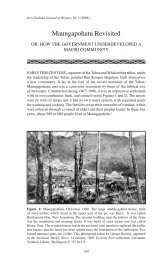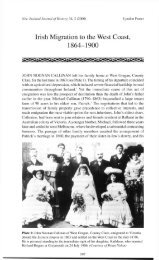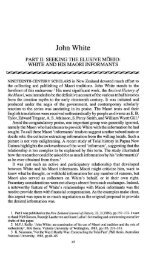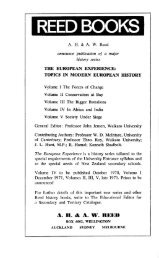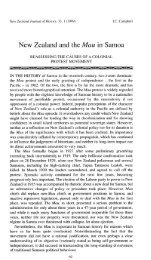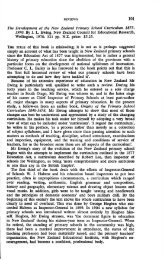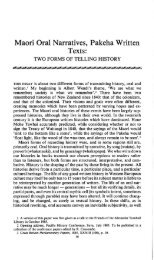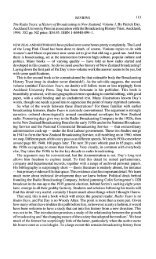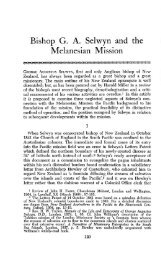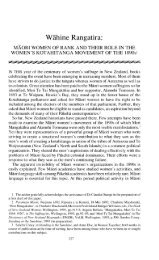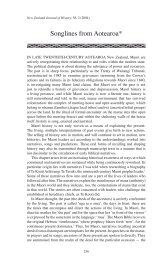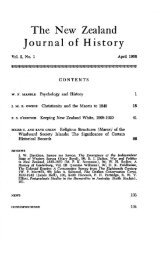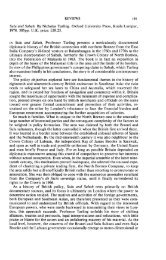Friendly Societies 1842-1938 - New Zealand Journal of History ...
Friendly Societies 1842-1938 - New Zealand Journal of History ...
Friendly Societies 1842-1938 - New Zealand Journal of History ...
You also want an ePaper? Increase the reach of your titles
YUMPU automatically turns print PDFs into web optimized ePapers that Google loves.
138 JENNIFER CARL YON<br />
underpaid and overworked. They considered the members' expectation to have<br />
access to all the modern methods <strong>of</strong> diagnosis and treatment whilst still paying<br />
the old scale <strong>of</strong> fees entirely unreasonable for '... an efficient conduct there<strong>of</strong><br />
not only takes up a great deal <strong>of</strong> a practitioner's time, but material used costs a<br />
great deal more than the bottle <strong>of</strong> medicine <strong>of</strong> his Victorian brother' , 62 There was<br />
also the issue, already referred to, <strong>of</strong> having to treat honorary members who could<br />
well afford to pay. In attempts to achieve what they perceived to be a fair deal,<br />
on several occasions the doctors went on strike and boycotted the friendly<br />
societies. They did this first unsuccessfully in Auckland in 1902 and then more<br />
successfully in Southland in 1913 and in Wellington in 1917. 63 By 1921 the<br />
friendly societies and the British Medical Association had negotiated a 'model<br />
agreement' and relations on the whole became more cordial.<br />
It was because <strong>of</strong> the difficulties experienced with the medical pr<strong>of</strong>ession and<br />
their desire to retain control <strong>of</strong> their own medical schemes that the different<br />
lodges in the larger towns such as Auckland and Wellington banded together to<br />
form UFS Medical Institutes. In January 1894, at their annual conference in<br />
Napier, the <strong>New</strong> <strong>Zealand</strong> Medical Association had unilaterally drawn up<br />
conditions <strong>of</strong> employment to be presented to the individual lodges. 64 Seeing this<br />
as a move to wrest control <strong>of</strong> their medical care from them, the friendly societies<br />
decided to form their own medical institutes based on the British and Australian<br />
models. 65<br />
In Auckland the first UFS Medical Institute was established in 1902. 66 By 1908<br />
22 lodges with a membership <strong>of</strong> 2791 had become affiliated. With dependants<br />
included, the institute was estimated to be providing medical care to approximately<br />
9000 persons. The second medical institute was established in Wellington<br />
in 1917, again in response to a boycott from the medical pr<strong>of</strong>ession. 67 By<br />
1929 it included 3260 members, plus their dependants.<br />
These institutes were managed by a committee <strong>of</strong> delegates from the affiliated<br />
lodges. They rented the premises, oversaw its upkeep, employed the doctors,<br />
determined their contracts and pay and dealt with members' complaints.<br />
62 Memo, Valintine to Minister for Public Health, 1916, p.2.<br />
63 For discussion <strong>of</strong> the Auckland and Wellington disputes see Carlyon, pp.30-53. For the<br />
Southland boycott, see Belgrave, p. 183.<br />
64 See Belgrave, pp. 180-84, in which he discusses the attempts <strong>of</strong> the <strong>New</strong> <strong>Zealand</strong> Medical<br />
Association (NZMA) to organize doctors against unjust terms. He believes that it was because <strong>of</strong><br />
their initially ineffective attempts to improve the conditions <strong>of</strong> society medical <strong>of</strong>ficers, that the<br />
NZMA decided to affdiate with the British Medical Association (BMA), p. 183.<br />
65 For a discussion on English medical institutes see Green, Working-class Patients, pp.21-27.<br />
For Australian medical institutes, see Green and Cromwell, pp.96-100.<br />
66 Carlyon, pp.30-41.<br />
67 Carlyon, pp.45-53.



